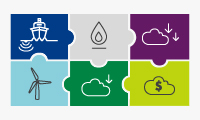Environmental data
Environmental data |
||||||||||||||||||||||||||||||||||||||||||||
|---|---|---|---|---|---|---|---|---|---|---|---|---|---|---|---|---|---|---|---|---|---|---|---|---|---|---|---|---|---|---|---|---|---|---|---|---|---|---|---|---|---|---|---|---|
|
2017 |
2016 |
2015 |
2014 |
2013 |
2012 |
2011 |
2010 |
2009 |
2008 |
||||||||||||||||||||||||||||||||||
|
||||||||||||||||||||||||||||||||||||||||||||
Greenhouse gas emissions (GHGs) |
|
|
|
|
|
|
|
|
|
|
||||||||||||||||||||||||||||||||||
Direct total GHGs (million tonnes CO2 equivalent) [A] |
73 |
70 |
72 |
76 |
73 |
72 |
74 |
76 |
69 |
75 |
||||||||||||||||||||||||||||||||||
Carbon dioxide (CO2) (million tonnes) |
70 |
67 |
68 |
73 |
71 |
69 |
71 |
72 |
66 |
72 |
||||||||||||||||||||||||||||||||||
Methane (CH4) (thousand tonnes)[B] |
123 |
138 |
132 |
126 |
120 |
93 |
133 |
128 |
127 |
126 |
||||||||||||||||||||||||||||||||||
Nitrous oxide (N2O) (thousand tonnes) |
1 |
1 |
1 |
1 |
1 |
1 |
1 |
2 |
2 |
2 |
||||||||||||||||||||||||||||||||||
Hydrofluorocarbons (HFCs) (tonnes) |
23 |
21 |
18 |
16 |
17 |
23 |
22 |
23 |
25 |
23 |
||||||||||||||||||||||||||||||||||
Energy indirect total GHGs (million tonnes CO2 equivalent) [C] |
12 |
11 |
9 |
10 |
10 |
9 |
10 |
9 |
9 |
n/c |
||||||||||||||||||||||||||||||||||
Flaring |
|
|
|
|
|
|
|
|
|
|
||||||||||||||||||||||||||||||||||
Flaring (Upstream) (million tonnes CO2 equivalent) [D] |
8.2 |
7.6 |
11.8 |
13.0 |
7.4 |
7.7 |
10.0 |
10.4 |
7.8 |
8.8 |
||||||||||||||||||||||||||||||||||
Flaring (Upstream) (million tonnes hydrocarbon flared) [D] |
2.5 |
2.3 |
3.5 |
3.8 |
2.1 |
2.3 |
3.4 |
3.6 |
2.6 |
2.8 |
||||||||||||||||||||||||||||||||||
Nigeria [E] |
0.8 |
0.5 |
0.9 |
1.3 |
1.1 |
1.5 |
2.0 |
2.4 |
1.9 |
2.3 |
||||||||||||||||||||||||||||||||||
Rest of the world [E] |
1.7 |
1.8 |
2.6 |
2.5 |
1.0 |
0.8 |
1.4 |
1.2 |
0.7 |
0.5 |
||||||||||||||||||||||||||||||||||
Energy intensity |
|
|
|
|
|
|
|
|
|
|
||||||||||||||||||||||||||||||||||
Upstream excl. oil sands, LNG and GTL (gigajoules per tonne production) [D], [F] |
1.05 |
1.02 |
0.83 |
0.87 |
0.89 |
0.83 |
0.75 |
0.74 |
0.76 |
0.74 |
||||||||||||||||||||||||||||||||||
Refineries: Refinery Energy Index [G] |
94.8 |
95.4 |
95.4 |
94.9 |
95.6 |
98.4 |
100.8 |
101.8 |
102.2 |
98.9 |
||||||||||||||||||||||||||||||||||
Chemical plants: Chemicals Energy Index |
88.2 |
91.0 |
91.6 |
90.3 |
89.8 |
91.7 |
90.8 |
89.3 |
92.0 |
93.0 |
||||||||||||||||||||||||||||||||||
Acid gases and VOCs |
|
|
|
|
|
|
|
|
|
|
||||||||||||||||||||||||||||||||||
Sulphur oxides (SOx) (thousand tonnes SO2) |
81 |
83 |
88 |
97 |
99 |
113 |
136 |
139 |
141 |
175 |
||||||||||||||||||||||||||||||||||
Nitrogen oxides (NOx) (thousand tonnes NO2) |
107 |
122 |
104 |
146 |
156 |
147 |
146 |
159 |
142 |
150 |
||||||||||||||||||||||||||||||||||
Volatile organic compounds (VOCs) (thousand tonnes) |
95 |
146 |
125 |
151 |
89 |
89 |
129 |
147 |
126 |
130 |
||||||||||||||||||||||||||||||||||
Ozone-depleting emissions |
|
|
|
|
|
|
|
|
|
|
||||||||||||||||||||||||||||||||||
CFCs/halons/trichloroethane (tonnes) |
0.0 |
0.0 |
0.0 |
0.0 |
0.0 |
0.0 |
0.0 |
0.0 |
0.4 |
1.4 |
||||||||||||||||||||||||||||||||||
Hydrochlorofluorocarbons (HCFCs) (tonnes) |
7 |
8 |
8 |
6 |
8 |
8 |
12 |
21 |
24 |
26 |
||||||||||||||||||||||||||||||||||
Spills and discharges [H] [I] [J] |
|
|
|
|
|
|
|
|
|
|
||||||||||||||||||||||||||||||||||
Sabotage spills – volume (thousand tonnes) [K] |
1.4 |
3.9 |
2.3 |
2.7 |
2.2 |
3.3 |
1.6 |
3.0 |
14.0 |
6.5 |
||||||||||||||||||||||||||||||||||
Sabotage spills – number [K] |
62 |
49 |
95 |
139 |
157 |
137 |
118 |
112 |
95 |
115 |
||||||||||||||||||||||||||||||||||
Operational spills – volume (thousand tonnes) |
0.3 |
0.8 |
0.8 |
0.7 |
0.9 |
2.1 |
6.0 |
2.9 |
1.4 |
8.8 |
||||||||||||||||||||||||||||||||||
Nigeria [L] |
0.1 |
0.3 |
0.2 |
0.3 |
0.4 |
0.2 |
5.3 |
0.7 |
0.3 |
7.1 |
||||||||||||||||||||||||||||||||||
Rest of the world |
0.2 |
0.5 |
0.7 |
0.4 |
0.5 |
1.9 |
0.7 |
2.2 |
1.1 |
1.7 |
||||||||||||||||||||||||||||||||||
Operational spills – number |
99 |
72 |
108 |
153 |
174 |
207 |
211 |
195 |
275 |
275 |
||||||||||||||||||||||||||||||||||
Nigeria [M] |
9 |
8 |
16 |
38 |
31 |
37 |
64 |
32 |
37 |
42 |
||||||||||||||||||||||||||||||||||
Rest of the world |
90 |
64 |
92 |
115 |
143 |
170 |
147 |
163 |
238 |
233 |
||||||||||||||||||||||||||||||||||
Hurricane spills – volume (thousand tonnes) [N] |
0.3 |
0.0 |
0.0 |
0.0 |
0.0 |
0.0 |
0.0 |
0.0 |
0.0 |
0.0 |
||||||||||||||||||||||||||||||||||
Oil in effluents to surface environment (thousand tonnes) [O] |
1.2 |
1.0 |
1.0 |
0.9 |
1.0 |
1.0 |
1.3 |
1.6 |
1.5 |
1.7 |
||||||||||||||||||||||||||||||||||
Water |
|
|
|
|
|
|
|
|
|
|
||||||||||||||||||||||||||||||||||
Fresh water withdrawn (million cubic metres) |
201 |
195 |
186 |
199 |
198 |
203 |
209 |
202 |
198 |
224 |
||||||||||||||||||||||||||||||||||
Fresh water consumed (million cubic metres) |
150 |
152 |
141 |
165 |
n/c |
n/c |
n/c |
n/c |
n/c |
n/c |
||||||||||||||||||||||||||||||||||
Waste disposal |
|
|
|
|
|
|
|
|
|
|
||||||||||||||||||||||||||||||||||
Hazardous (thousand tonnes) |
638 |
658 |
455 |
529 |
770 |
820 |
740 |
1,048 |
962 |
688 |
||||||||||||||||||||||||||||||||||
Non-hazardous (thousand tonnes) |
1,382 |
1,491 |
1,680 |
1,674 |
2,065 |
2,295 |
1,850 |
1,079 |
1,139 |
996 |
||||||||||||||||||||||||||||||||||
Total waste (thousand tonnes) [P] |
2,202 |
2,148 |
2,135 |
2,203 |
2,835 |
3,115 |
2,590 |
2,127 |
2,101 |
1,684 |
||||||||||||||||||||||||||||||||||
 Sustainability at Shell
Sustainability at Shell
 Sustainable development goals
Sustainable development goals
 About our data
About our data
 Energy transition and climate change
Energy transition and climate change